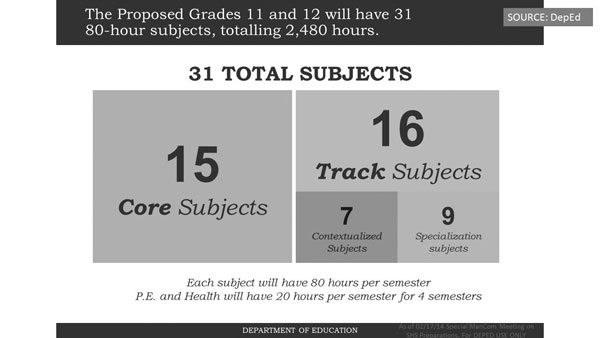The SHS core subjects
Senior High School is not only about giving everyone a chance to earn a living before they enter college. It is also about giving everyone a chance to continue to college.
From the four Tracks available to the student entering Grade 11, the Academic Track clearly prepares students for college. But so do the other Tracks. Let us talk about the courses that everyone – not just those choosing the Academic Track – has to take that will prepare them for college-level work.
The SHS curriculum consists of three different types.
There are 15 Core Subjects. There are seven Contextualized Subjects and nine Specialization Subjects. Together, the Contextualized Subjects and the Specialization Subjects make 16 Track Subjects. Thus, the total number of subjects that a student takes during the course of Grade 11 and Grade 12 is 31.
Each subject takes 80 hours per semester, except for Physical Education and Health, which takes only 20 hours per semester for four semesters.
If the numbers get you all confused, the diagram should help.

All students take the Core Subjects, which have the same content and the same competencies. (DepEd calls “competencies†what others call “standards,†“outcomes,†“skills,†or “products.â€)
These subjects are the following:
- Oral Communication
- Reading and Writing
- Komunikasyon at Pananaliksik sa Wika at Kulturang Pilipino (Communication and Research on Filipino Language and Culture)
- Pagbasa at Pagsuri ng Iba’t Ibang Teksto Tungo sa Pananaliksik (Reading and Critique of Different Research Texts)
- 21st Century Literature from the Philippines and the World
- Contemporary Philippine Arts from the Regions
- Media and Information Literacy
- General Mathematics
- Statistics and Probability
- Earth and Life Science
- Physical Science
- Pansariling Kaunlaran (Personal Development)
- Understanding Culture, Society, and Politics
- Pambungad sa Pilosopiya ng Tao (Introduction to the Philosophy of the Human Person)
- Physical Education and Health
You can see at once that the SHS curriculum follows and builds on the K to 10 curriculum, which consists of English, Filipino, Math, Science, Social Studies, and MAPEH (Music, Arts, Physical Education, Health). Since the entire curriculum is now spiraled (i.e., students learn a little bit more about each subject each year), these subjects are mere developments or reinforcements of earlier learning by the students.
There are, however, subjects in the SHS curriculum that are not specifically in the K to 10 curriculum. These are the humanities subjects (literature and arts), the media subject, and the philosophy subjects. We can trace the origin of these subjects to the old (but still current) General Education Curriculum used in college. The literature subject is roughly equivalent to the two literature courses required in Colleges of Arts and Sciences. The media subject is sometimes offered as an elective in colleges. The philosophy subject comes straight out of introductory college philosophy courses. In short, although they look new when listed in the SHS curriculum, they are really old subjects in the education continuum.
If all the subjects are more or less what they used to be in the old high school and college curriculum, though admittedly more advanced, what then is really new in SHS?
What is really new is a period of Immersion. There is no satisfactory word for this element yet, but it is like Internship or On the Job Training or Apprenticeship. Since there are various laws that cover internship, OJT, and apprenticeship, and since these laws assume that the student is not a high school student, the word “immersion†is probably as good a word as any.
What is immersion? It is a way to allow students to get out of the campus and do actual work in a workplace.
Workplace, of course, does not only mean a factory. That would be true of most students choosing the Technical-Vocational-Livelihood (TVL) track, but even TVL students might work at home (if they are learning how to sew or cook, for instance, or if they will help out in farms). A student in the Arts and Design Track might work for some time in an orchestra or in an art studio. Even a student following the Academic Track might work for a few days in a science laboratory, helping out a senior or professional researcher.
What is crucial is not where or what exactly the workplace is, but that the students will learn by actually doing something that adults do every day.
(To be continued)
- Latest


























 Partner
Partner